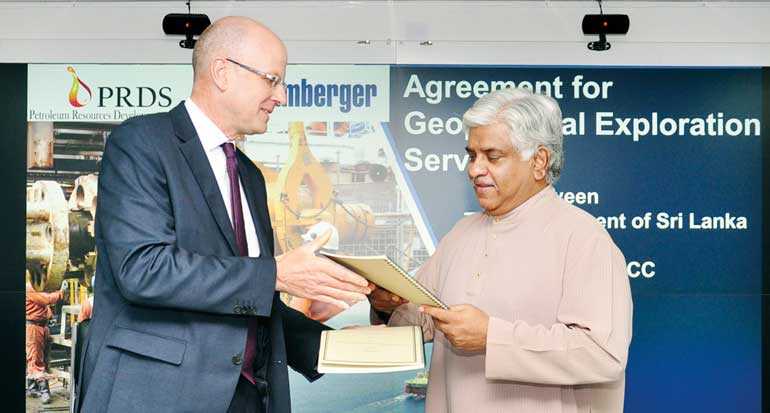Monday Dec 22, 2025
Monday Dec 22, 2025
Thursday, 31 May 2018 00:23 - - {{hitsCtrl.values.hits}}
 The agreement exchange by Petroleum Resources Development Minister Arjuna Ranatunga and Schlumberger Multiclient Eastern Hemisphere Vice President Phil Davey – Pic by Sameera Wijesinghe
The agreement exchange by Petroleum Resources Development Minister Arjuna Ranatunga and Schlumberger Multiclient Eastern Hemisphere Vice President Phil Davey – Pic by Sameera Wijesinghe
By Uditha Jayasinghe
Kicking off the latest effort to find oil and gas off Sri Lanka’s coast, the Government yesterday signed an agreement with Eastern Echo DMCC, a subsidiary of oilfield services company Schlumberger, to begin gathering seismic data of the east coast.
The agreement was signed by Petroleum resources Development Minister Arjuna Ranatunga and Schlumberger Vice President Multiclient Eastern Hemisphere Phil Davey at the Petroleum Resources Development Secretariat (PDRS). Eastern Echo DMCC would initially gather seismic data in two blocs titled JS 5 and JS 6 that would span from Mullaitivu to Batticaloa.
The company aims to invest $50 million. Previously, Sri Lanka had concentrated on the Cauvery Basin off Mannar, but officials had opted to gather fresh information on the eastern coast.
“It took us a considerable amount of time to set out this agreement in a way that would benefit Sri Lanka. There were several rounds of discussions that included the Attorney General and the final draft was made with his approval. This agreement is made on a multi-client basis and is valid for ten years. This means any seismic data from it will be owned by the Government, and when it is used by any company, a share of its earnings will come to the Government. It is my belief that this process will provide Sri Lanka with a chance to become energy-secure, and I think it will be a very important step,” the Minister said.
The Government plans to call for bids in the next two weeks to conduct development work on the gas deposits uncovered by Indian company Cairn during a previous seismic data gathering exercise that began around 2011. Two natural gas deposits were announced in 2014, but Cairn pulled out of Sri Lanka in early 2015. However, Eastern Echo DMCC would be engaged in only collecting seismic data, which would be gradually expanded beyond the eastern shore.
“We are at an interesting phase of understanding the resource potential of the country. We are very excited and plan to start work in August. Currently we are looking at analysis on the offshore eastern side with new seismic data to understand the potential and possibly expand to the rest of the country later,” Davey told reporters.
The company plans to gather data for two months and take six months to get the initial analysis. Davey noted that it could take up to a year to understand the geology of the data, which would be the first step to understanding if potential oil deposits exist in Sri Lankan waters.
“There is some geology that is interesting, some indication there might be a working petroleum system, but only once we start acquiring data and after detailed analysis would we know if there is anything to extract. But, this is bringing new technology to the country, and the understanding potential would improve,” he added.
Davey also pointed out that since the global seismic industry has become technologically advanced, even repeating the same work in the same area would still increase knowledge. “In this particular project, we are starting to look in a different part of the country, and the knowledge developed from other success cases would be applied. It is very early days yet, so we do not know how things will progress. We are also working with PDRS to take existing data and use new processing data to improve understanding of data we already have.”